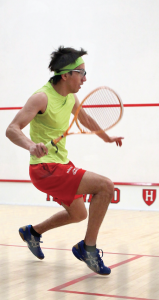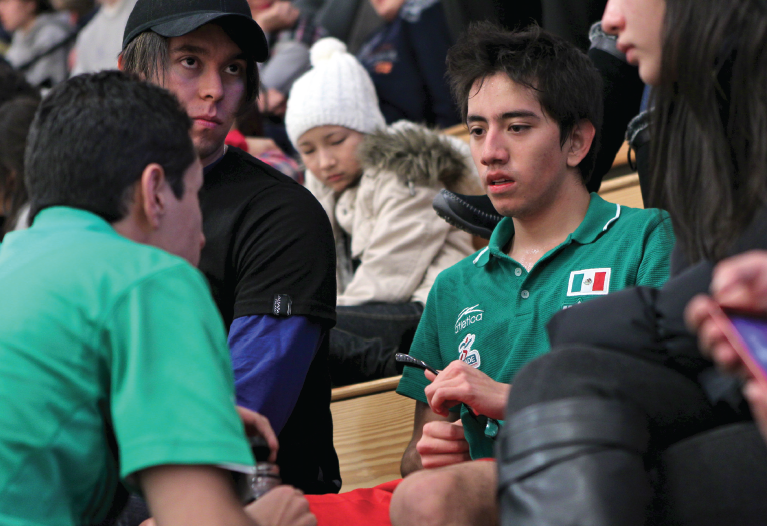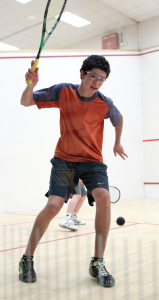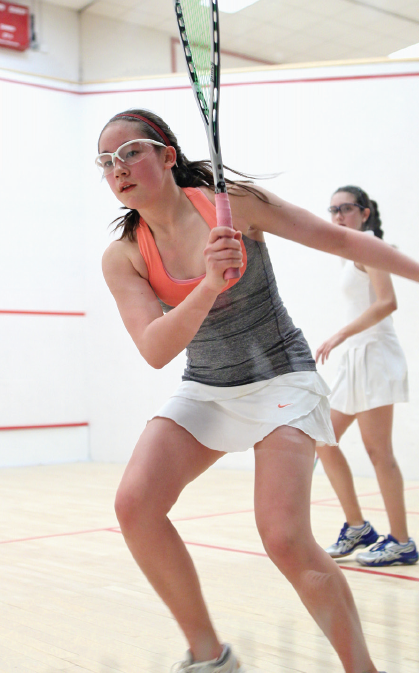By Vidya Rajan
Photos by Jay D. Prince
With 650 players from 20 different countries, the US Junior Open cemented itself as one of the premier junior tournaments worldwide. Played at Harvard University this year, the tournament drew players from across the globe, many representing their nations for the first time and other, more seasoned players representing theirs for the sixth, seventh, and even eighth time.

One such seasoned player was Canadian Nick Sachvie, Boys’ Under-19 champion. The title was a birthday gift to Sachvie, who turned 19 the day after the tournament ended. Sachvie, a sophomore transfer student at Cornell University, ended his junior career in style by winning the final in straight games over Miled Zarazua of Mexico.
“I was excited to play this tournament and I wanted to win it,” Sachvie said. “One of my concerns was that I’m playing college squash now, and I didn’t know if I wanted to go back and play juniors. But I wanted to finish my junior career right, and go off with a big win.”
This win capped an illustrious junior career consisting of multiple US and Canadian Junior Open wins, a string of Canadian junior national titles, and a third-place team finish at the World Junior Championships this summer, making Sachvie a tough force to be reckoned with.
Despite the challenges of maintaining his academic commitments—such as having exams to complete the day before the start of the tournament—Sachvie has been able to sustain a high level of play at Cornell as their top men’s player. “My coach takes it seriously, and so do I,” he said. “We have a good team and everyone is able to push each other, so I’m motivated to keep going.”
Sachvie’s win also marked the end of a long-standing rivalry with his opponent, Miled Zarazua. Over the past eight years, the two have played each other in the final of the US Junior Open, the Canadian Junior Open, or both—multiple times since their days in the Under-13s. Their last match-up was in the final of the 2008 Boys’ Under-17 division of Canadian Junior Open, at Sachvie’s home courts in White Oaks, Toronto. Zarazua had won the match in three, and the memory of that loss was a special motivating factor for Sachvie this time around.
“Miled has been a rival through the ages,” Sachvie said. “Finishing my junior career against him, I knew how he plays, and he’ll always be a good player.” Perhaps the two will meet again in the intercollegiate circuit, as Zarazua will be joining Trinity College in January, an undeniable asset to their existing powerhouse of a team.
Another fabulous addition to an already successful team will be Girls’ Under-19 champion Amanda Sobhy to the Harvard University team come fall. Sobhy swept the title with ease, waltzing through an uncontested final against second seed Olivia Blatchford. Though Sobhy went down 5-1 in the first game, she collected herself to win that game and the next two with speed and authority.
Although at 17, both players are already making rounds of the professional circuit—with Sobhy ranked at 26 worldwide and Blatchford at 47—their junior rivalry is one that has also blossomed over the years. Sobhy has won three of their past four matches, but in particular she wanted to avenge her loss in the 2009 US Junior Open. “It’s always mental with Olivia because we’ve played so many times,” Sobhy admitted. “I’m always a little nervous going in, but I’ve had a lot of good wins over the past few months.”

In particular, Sobhy’s recent successes have included the world junior title in June, 2nd place in the US Professional Open in September, her fifth WISPA title in October, three medals in the Pan-American games in November— including a gold in the team event, a silver in the mixed doubles event, and a bronze in the individuals—a seventh place finish in the women’s world team event in December, and finally, the US Junior Open title without the loss of a single game.
Going forward, Sobhy is looking to defend her world junior title and to make even more progress in the professional circuit before joining Harvard in the fall. “I love the pro circuit, but education comes first,” Sobhy said. “Not being able to travel as much to play will be sad, but I am very excited for college squash.”

Her win was surely to be one of many on her soon-to-be home courts.
Though both Under-19 finals finished relatively quickly, the Under-17 finals were each drawn out to five games, keeping the crowd on the edge of their seats throughout. In the Girls’ Under-17 division, Olivia Fiechter of Philadelphia beat Maria Elena Ubina of Baltimore after being two games down. Though Fiechter had recently beaten Ubina in three in a tournament the previous month, Ubina came out with determination and poise. Fiechter effectively countered this, however, with her aggression and speed later on in the match.
“I was expecting her to come out firing,” Fiechter said. “I just tried to stay calm and keep my intensity up. My coach told me not worry about her game, and to be confident in my skills. I started going for more shots and being more intense with my movement.”
Her tactics clearly paid off, and this title marks Fiechter’s second, to add to her multiple US Junior National titles— and hopefully more to come.
The Boys’ Under-17 draw saw an all-Egyptian final between Fady Sarwat and Osama Khalifa, former British Junior Open champion and semifinalist. Arguably demonstrating some of the most entertaining squash of the tournament, Sarwat won in five tight games to capture his maiden US Junior Open title. According to Khaled Ghoneim, one of Sarwat’s coaches, Sarwat and Khalifa have often met each other in tournaments in Egypt, though they play out of different clubs. “It was a difficult title,” Sarwat said, “but I’m happy to win it and I hope to play this tournament until I finish my junior levels.”
With 20 players representing Egypt this year—the most since Egyptian players began participating in the US Junior Open four years ago—their presence has surely prompted the expansion of the tournament and the advent of other nations as well.
“Egyptian attendance is the best thing that happened to the US Junior Open,” said Maged Maksoud, an Egyptian parent, of the tournament as a whole. It certainly has been advantageous, as having a higher caliber of players has lent the tournament more credibility as a whole. More countries are beginning to send players for the first time, and as their players perform well they are prompted to sustain the trend.

A prime example was Diego Elias, Boys’ Under-15 winner who was playing in the tournament for the first time. Elias and another player were the only two from Peru, where Elias is ranked tenth among adults and is coached by his father, Josemanuel Elias, who is the reigning Peruvian national champion. In the final, Elias met Guillermo Cortes of Mexico, last year’s Boys’ Under-13 champion, and Elias prevailed in four hard-fought games. The victory was Elias’ second in two weeks after winning the Canadian Junior Open the previous weekend.
“We admired the organization of this tournament, and we hope to bring more players from Peru,” Josemanuel Elias said. “You’ll be seeing more of us!”
In the Girls’ Under-15, Reeham Sedky of Seattle, Washington, powered her way to her fourth straight title, this time over Sabrina Sobhy of Sea Cliff, New York, in a repeat of last year’s semifinal and the previous year’s final. Sedky won the title without dropping a game, stopping at nothing through the tournament to dominate the Under-15s—despite the fact that she has another year to do so.
Sedky, in fact, led a young Seattle con- tingent to victory in the Girls’ Under-13s and Girls’ Under-11s, where Helen Teegan and Elena Wagenmans won respectively without dropping any games. Teegan, a nationally top-ranked swimmer as well, won the title without batting an eyelid—save for her 18-16 first game win in the final against Jessica Yacobucci of Greenwich, Connecticut. The win was her second US Junior Open title, the first being the Under-11 title in 2008. Wagenmans took her second title as well, proving too strong for the Under-11 draw.
Also representing Seattle was the lone American finalist across all of the boys’ divisions, Salim Khan of the Boys’ Under-13 division. After a nail-biting, five-game semifinal match against top seed Jacob Ellen, Khan faced pint-sized Egyptian Mohamed El Shamy in the final but fell short in four tough games. The win was Egypt’s second of three, the third being in the Boys’ Under-11 division as Aly Abou El Einen defeated Alejandro Enrique of Guatemala.
In all, the tournament ran smoothly despite its size and inevitable chaos. Many players decided to play for the increased visibility and for the exposure to the potential of playing for an American university in the future. This opportunity certainly helped in the tournament’s expansion, and hopefully the trend can continue in years to come.





